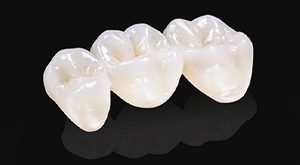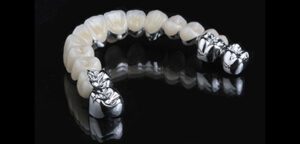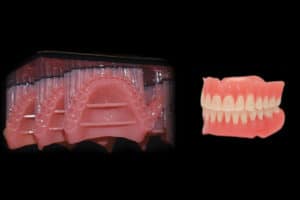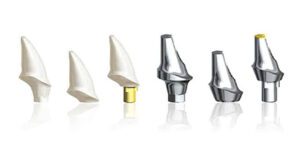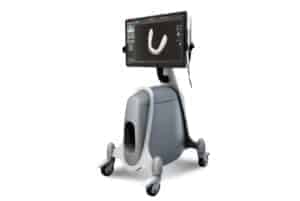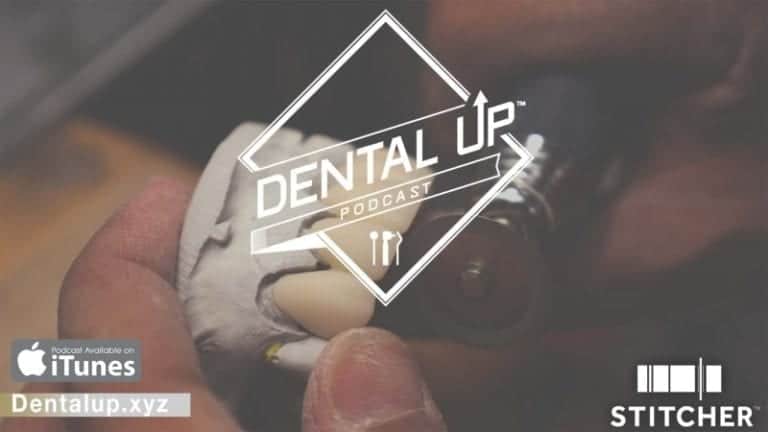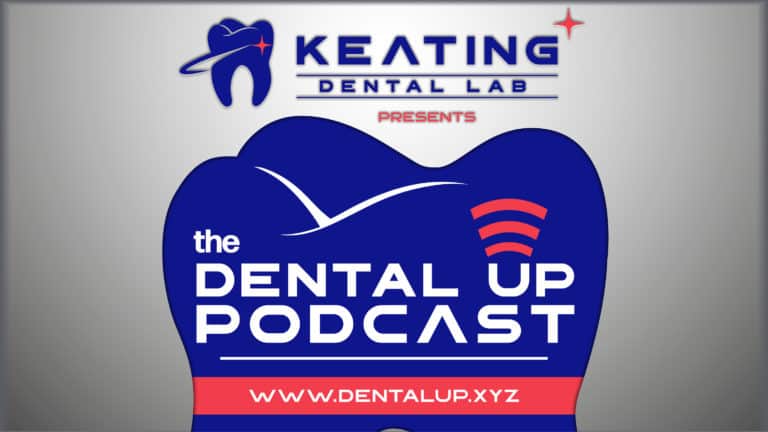With the power of CAD CAM computer technology, the future of digital dentures is extremely imminent. Shaun and leading members of Keating discuss the high probability of offering a seamless integrated digital denture system that will allow dentists to cut patient visits in half, maximize chair time, lower the cost of our product, increase precision and consistency without having to invest in expensive technology.
Full Transcription:
Shaun Keating: Hey, everybody Shawn Keating here. I would like to welcome you to this week’s Dental Up podcast here at Keating Dental Lab. We’re in Irvine, California and we would love for any of you guys to come on by, if you’re in the area. We’d love you to come see the laboratory, meet the technicians, kind of see our facilities, we’d always love to have you come by.
This week, we are talking with two of our head people here at Keating Dental Lab. Bob Brandon, our general manager, and Jim McKacren, he is our senior lab technician, and he is in charge of our removable department, and it is great to see you guys, and talk to you. Jim McEachern: Thanks for having us. Bob Brandon: It’ll be cool. Shaun Keating: Thanks for coming on in. Well, you know I like to start off talking about sports, and Bob, I know you are a real big sports guy. Jim, what about you? Jim McEachern: I’m not too big on sports, I like more yachting, and sailing. Shaun Keating: There you go. Jim McEachern: Outdoor sports. Shaun Keating: High school, are you into like, badminton, or what dude? Jim McEachern: No, no, I was a gymnast. Just like you, I was a gymnast. Shaun Keating: Really? You’re kidding? Jim McEachern: I led our varsity in gymnastics. Shaun Keating: I led our varsity in gymnastics as a freshman, what about you? Jim McEachern: I was not that early, I was a junior. Shaun Keating: Oh, what were you hiding? I never knew that and all and we’ve been together for 30 years. Jim McEachern: 30 years, yeah. Shaun Keating: We never talked about that. Jim McEachern: No, free exercise and tumbling. Shaun Keating: Really? So that’s called “floor” Jim McEachern: Floor. Shaun Keating: And then what, pommel horse? Or what’s free exercise? I’ve never heard of that one. Jim McEachern: No, tumbling. No just regular tumbling. [crosstalk 00:01:23] Bob Brandon: So floor exercises yeah. Shaun Keating: My big thing was, I was the high bar man. I used to swing that high bar and it’s just crazy to get up there and do the crap that I did. We just had our 40 year, not 40 years, whatever how many years, class of 80, 1980, that sounds crazy. Jim McEachern: I got one that’s crazier, 1965. Shaun Keating: Oh dude, I was still on Mama’s tit! We breast fed back then until we were 8. Bob Brandon: That’s funny. Shaun Keating: Dude no kidding. Jim McEachern: Yep that’s when I graduated, 1965. Shaun Keating: Oh my gosh that’s crazy dude, you look so young and man you’ve been doing this a long time. How many years, you 40+ years? Jim McEachern: 51 years. Shaun Keating: 51 years you been doing this. No wonder all our doctors always love to call you up and say, “give me Jim McKacren”. Dude. Jim McEachern: Yeah I got a lot of experience under my belt. I started back in the military, 1966 during the Vietnam War. I was in the Navy for 4 years. I was trained in the Navies and I was actually trained in removable, then I went to fix and throughout the career I was able to work with Dr. Niles Guichet who invented the Denar articulator. And I managed his lab for 11 years so everything we did there was on pantographic tracings. A little bit different then what we do today and I think most of the young practitioners today don’t even know what a pantographic tracing is. Let alone a [inaudible 00:02:46]. Bob Brandon: Scary. Shaun Keating: That’s cra- and Guichet is still working isn’t he? Jim McEachern: No Dr. Niles retired about 5 years ago. Shaun Keating: Okay, yeah I thought he was still- Bob Brandon: David and Greg. Jim McEachern: But David and Greg, his sons are running the practice for him. Shaun Keating: No kidding and they’re dentists also, David and Greg? Bob Brandon: Yeah, they’re prosthodontist yeah. Shaun Keating: Prosthodontists. Yeah they’re at New Port beach right? Jim McEachern: They’re in Orange. Bob Brandon: Orange. Shaun Keating: Orange, okay. I was thinking of someone else. Jim McEachern: At Providence Dental group. Shaun Keating: What a trip, small world dude. So that’s awesome. Okay well back to sports real quick, our Mighty Ducks man. Last time I think I talked to you guys they were down 2 games to none to Edmonton and they’ve come back and they tied it up and then they went up 3-2, and then they got hammered last- Bob Brandon: Smoked yeah. Shaun Keating: Smoked, like 7 zip or something. Bob Brandon: Yeah the first period. Shaun Keating: So crazy, and that will mess with you mentally. So tonight we got em at the Honda Center, I’m heading on over. It’s gonna be a game 7, you know and I guess they’ve lost the last 5 times in game 7. Bob Brandon: Usually to the Kings. Shaun Keating: God no kidding, so big thing in Anaheim today, we’re heading out early. We do the tailgating out there like 2 hours ahead of time man, but just give us a reason you know to tailgate. It could be the fricken monster truck rally, we’re gonna tailgate. But yeah so we got that going. Angels are looking pretty good, Trout’s been out for a little bit but he’s coming back soon. But you know not a whole lot, I got my butt handed to me in the darn Kentucky Derby last week. You know and I talked a while back about you know I don’t gamble much but I got into the horse racing and dude I tell you man, it’s like-. I thought you bet favorites you might win a lot but you know it’s probably a 50/50 when the favorites coming or not, so it’s not really the best bet. So I bet on Classical Empire I think it was and Always Dreaming, I was thinking about that because I’m kind of a dreamer and my son’s wife Meredith she’s like, “[inaudible 00:04:47]Always Dreaming”. I’m thinking, “Come on girl, you don’t know what the heck you’re thinking” man. No I know I’m the horse guy so I go down there with Shannon, me and pick up my ticket and stuff and we go watch that thing and sure enough we don’t even see Classic Empire the whole race. He’s in the back. It’s like what the heck. He came on finish 4th, but who won, Always Dreaming and I would’ve won. Yeah, it’s just, but it’s fun. The horse racing I like watching it but it’s always neat when your horse comes in but dang it’s like gambling’s not good, there’s a reason like in Vegas all those Casinos are built and all that. It’s cause there’s a bunch of knuckleheads out there betting thinking they know what they’re doing and they always end up winning so. Listen to me, don’t gamble if you don’t money and even if you do got money, go give it to somebody or something and you’ll get more out of it. You get more happiness by giving than receiving, I think that’s in the scripture somewhere not that I know, I’ve heard that but I like giving more than receiving too. But anyways okay let’s dental up a lit bit here guys. We just got the CDA that’s why Bob I had you come in. We ran that show last week, Jim did you get out and work the show? Jim McEachern: No I didn’t work the show, I’m going to Lab day this coming weekend. I actually got the whole department going out. We are already registered and we’re looking forward to getting there. Shaun Keating: Yeah that’s awesome. We need to, we get all our fix guys over there too and see what’s new and up and coming but you know it was really neat king of seeing a lot of our existing accounts in Anaheim at the CDA. I enjoy doing that show because it’s a lot of our local doctors and stuff. But Bob you came up with something with, who’s these guys out there that are called, “World’s First Cad/Cam Denture”, why don’t you guys tell me a little bit what you thought about it. I thought it was amazing, cause you know I mean it’s 4-5-6 visits for these darn things and man I never liked doing removal, I never did it. I’m a fix guy but when I started my lab about 15 years ago on our own, we kind of had to do it after a while. My doctor’s kept going, “Shawn I just want to work with you total with the removal combo cases with the fixed”. And it really is important to work together you know that way. So we started the removal department and it frustrates the heck out of me. It’s hard, we have a lot of people that have to do a lot of things for just a little bit of work, but it’s a service and we have to do it in conjunction with our fix. So I think it’s important but really making strides. Jim I thank you so much for coming in and taking over the role of watching it the last year or so and it’s been a while now. Jim McEachern: Been a year. Shaun Keating: Yeah been a year and I just can’t thank you enough. I know a lot of my fix doctors always go, “Where’s Jim?” And they’re tracking you down. Jim McEachern: I know they find me and I still answer their calls but that’s more important that we take care of our customers, whether it’s fixed or removal. Shaun Keating: Absolutely, hey the customer is always right. Always, you gotta take care of them man, that’s what sets ourselves apart for sure. But Bob tell me a little bit about what you saw and then we can kind of talk about this a little bit. Bob Brandon: Yeah so in keeping with your theme of being a giver, this-. Cad/Cam is infiltrating all industries and all facets of our industry both from the clinician side and on the lab side. And by incorporating Cav/Cam into the removable department, it’s gonna allow us to give and provide our customer base with a very high quality product at a more cost effective solution. And it’s gonna save our dentist customers money because it reduces the number of chair side visits and it’s also going to allow us as a laboratory to produce the final processes, you know a less labor intensive manner because we are going to incorporate Cad/Cam steps. It’s the same thing that’s been happening for the past 10 years easy on the fix side, it’s now slowly incorporating into the removal side. And this is a really neat company. They’ve worked behind the scenes with several other removable companies that are infiltrating into the market right now. They’ve got a really nice set up and really honestly very pretty materials to work with. Shaun Keating: They’re saying almost like 2 steps, 2 visits, in a way. And we’re at 4-5. I just can’t- Bob Brandon: I kind of foresee it as 3 visits really if I’m understanding their work flow correctly. Shaun Keating: You’re right, that’s correct. Bob Brandon: But really their key is their tray system and once you see it and once you get it in your hands and you understand how it incorporates the vertical dimension [inaudible 00:09:24] tracing nearly simultaneously, it’s really unbelievable. And that’s going to improve the accuracy, that’s gonna result in fewer remakes and resets, but really the first visit is for impression taking, determination of VDO, the tracing and then you’ve got to take a physical measurement of the lip drape and where you want to put the central incisors. And really that reduces your first visit in half really if you think about it on an hourly basis because all the technology is built into the tray system. Your second patient visit is a try-in. It’s a base try in and teeth try in. And it’s all- Shaun Keating: We can’t just go to a finish, like balls to the walls? Bob Brandon: Well, I don’t [crosstalk 00:10:12] know you probably could. Shaun Keating: My thing is [inaudible 00:10:15] lie on the right bite and everything, I don’t know. But go ahead. Bob Brandon: You know what if we develop some consistency and if we do a really good job on the design and there’s a way that the customers can take a look at the set up you know, again it’s on a computer screen you don’t have the face, you don’t have the lips or anything like that but you know. If we’re able to work with one customer and do 10 cases, 20 cases whatever you want to set that number at and if we have success on the first 20 cases, I see no reason why we can’t go straight to finish. Shaun Keating: Kind of like how we used to always say with Bisque Bakes, these doctors you know when you get a bigger round ear, bigger anterior case, bridge work or whatever especially, they always say, “Send it in a bisque” and after a while I was like, “Dude treat it like a bisque but let me just finish the case”. And treat it like a bisque because even when it’s a bisque if we have to add to it, they’re adding to it maybe with some wax or saying, “Shawn I need these laterals 2 tents higher or 3 tents longer. I need little bit more [inaudible 00:11:21] on the centrals and/or round off the canine’s a little bit”. So I used to always say treat that final glaze unit the same way you do as a bisque but 99% of the time it would drop right into play. Bob Brandon: Absolutely. Shaun Keating: And that just comes with thousands and thousands of units over and over. So I’m not saying we could do it immediately with this, but weren’t these guys real big with [Avue? 00:11:43]. Isn’t Avident a- Bob Brandon: Well it’s a different system if I’m understanding their business development correctly. I do not believe they worked with Avident, but I do know that they worked with Huraeus Kulzer and the Pala system. Shaun Keating: That’s it, Pala. So that’s Kulzer. And what do they do with Kulzer, they do their trays or something? Jim McEachern: It’s similar. They don’t have a tray system. The advantage like Bob said to this particular system that they have, the tray system is the fact that you can get everything done at one time at one sitting. You don’t have to do a base plate and a bite rim and it reduces the chair time from 5 appointments to maybe 1 hour appointment. The other thing that, and when you were talking about doing a bisque bake, they make actually a prototype denture and that prototype denture is treated as a bisque. Then the fact that if the patient wants something changed, a tooth rotated or they wanted to distals or the centrals rounded, that prototype is what the doctor puts in the mouth, they check everything out, they return it to the laboratory and we go to a final processes. The different with Huraeus Kulzer is there’s a multiple steps. They do it digitally as well, but then we have to go back and they provide us with a jig that we have to go back in and reduce our dentures teeth. After we put them in there Jake, we have to reduce it, reduce the denture teeth, put them on-. There’s a lot more steps involved than in a lab procedure, whereas this like you said you could take it right to a finish if you have a good operator that we’ve done this for 9-10 times and it’s consistent, you can repeat it, it’s repeatable all the time. It’s just very fool proof type system but the difference is they have everything and that’s the most important thing, which we provide from the laboratory. We can provide the kid, we can provide the trays, we can provide the tracing system. Doctor can go online and just go over a simple process of looking at it and it’s a 1-2-3 step. And the trays they are adjustable, you can adjust them. You can border mold them. There are a lot of things- Bob Brandon: But you don’t have to use the trays, it’s not a locked in system. Jim McEachern: No it’s not a locked in system. You’re absolutely right. Bob Brandon: Our doctors can experience the digital denture fabrication process using conventional techniques. So it incorporates, you know it’s a wide net, so it incorporates the pure digital method with the trays and then us actually scanning the impressions where we don’t make a physical model, we scan the impression. Jim McEachern: We scan right. Shaun Keating: So that’s why we can get everything from it and when it comes to our lab we’re just scanning on our own. Bob Brandon: Correct. We’re scanning, then we send the files just like we would send the files to our own machines for executing a Zerconia [crosstalk 00:14:33]. We send the files to them, they design the base, they design the teeth, and then they send us back the prototype which you know our customer tries in. Everything’s great then we print out the final set. So we print out a base, and then we print out the teeth, and then we process the two together and there’s your final set. So really we’re doing no model work, we’re doing no mounting, I mean if we’re working on the pure digital method. And that’s where- Shaun Keating: The savings yeah. Bob Brandon: We’re going to be able to save our customers, we’re also going to be able to save our labor, absolutely. Shaun Keating: Big time. I mean we’re talking like at least $50 off less probably on our denture, on our economy denture, and our ultimate denture. At least $50. And I know that’s gonna make doctor’s happy and I just think with the way Cad has worked for us with our monolythics, the consistency and accuracy is just so freaking on the money that the way I was looking at this system for our dentures, and we don’t do a lot of dentures, we might do 50-60 a month, but still dude, that could really help us labor wise cause it’s so- and labor intensive. Bob Brandon: Intensive, it really is. And the other thing too, the savings is not only what we can pass on to the doctor monetarily, however the savings chair side, is chair side. 3 appointment at least, at least 3 and I don’t know what the chair side monetary conversion is- Shaun Keating: Well I mean I always say it’s 3-5 hundred dollars [crosstalk 00:16:11] an hour with overhead and everything else if you really do your numbers. But to get a doctor that, you know, to go from 5-6 visits to 2-3, that’s gonna make them excited right there. Not even talking less money, but just to cut the time in half and to cut the price by a 20%-30% cut, it’s gotta be exciting. And I just think more so than the money than anything is the time. Cause time is money and also just the accuracy and consistency. I have a feeling these are going to be fitting those ridges really nice and I just have a feeling the way we’ve got it dialed in with our scanners that with [inaudible 00:17:03] and everything else, we can really get these patients dialed in. Bob Brandon: Not only that, but when you’re working digitally, there’s permanents. There’s storage and you’ve got a record if Mrs. Jones misplaces her [inaudible 00:17:15] arch and she’s still wearing her lower and- Shaun Keating: We’ll print it to the exact dimension she has. Bob Brandon: Absolutely. Shaun Keating: At a nominal fee doctor, but we can have a, you know- She needs a new one anyways, it got caught in the garbage disposal or something. Dang, give me a standby, have one in each bedroom or something. We’ll go direct to the patient. You know what we’ll give these to you at 265 each, or whatever. That’s great man. So what’s the lop rules and the jaw gauge and all this other stuff. Jim McEachern: Well that comes in the kit they have for the doctors. It’s not only a system of trays, but they have everything to take the necessary measurements [inaudible 00:17:55] measurements. The measurement from the base of the nose to the lip as they call it the lip drape, which is really important. They have all of this available and if they follow the protocol, then it becomes very very predictable. It cuts their chair time down as we already discussed, you know by 2-3 visits anyway. And this is what’s so exciting about this system, it’s that it’s well thought out, it’s not a piece here and a piece there and then we have to do that, this is all complete and it’s very very predictable. And for an affordable denture for people that are out there that really can’t afford the premium denture base, it makes it not only for aesthetic value but for function too. At leas they’ll be able to eat, there are so many people out there in the world that have no dentures because they can’t afford them. This is an affordable denture- Bob Brandon: It’s going to open up the market. Jim McEachern: And this will open up the market most definitely. Shaun Keating: We’ll still be able to do our premium with them with [crosstalk 00:18:54] Jim McEachern: Oh absolutely, absolutely, with premium teeth. Bob Brandon: It’s the same principal again working with Zerconia where we could design something in a cut back fashion and then we can stipple it, we can characterize the base, we can characterize the teeth. You know working digitally you can ask for a 10& cut back, 20% cut back and yeah we’ll be able to jazz it up with our artistry and [crosstalk 00:19:16] technicians. You know we can make an ultra premium denture with this. Shaun Keating: That’s so cool. I mean it really is the blueprint of the dental lab with, I’d probably be at 500 people now if it wasn’t for all the machines or whatever. It’s just you don’t have to have so many humans but yet it’s always great to have the best humans that are kind of overseeing what you have and working on it cause we’re still going to have all our denture finishers and everything that really finesses at the end of it all- Bob Brandon: You need a human being at the end, you need a technician with skills on occlusion, aesthetics, function, everything. It does take a human at the end for the finishing for sure. Jim McEachern: That’s awesome. Shaun Keating: Well that’s great to know. Usually you have to go to Germany to you know the IDS or whatever to get good stuff like this and I’ve seen a lot of different little systems out there but has it been around for a while or they- Bob Brandon: It’s been around for about 8 years. Even in the US market, they’ve been around for 8 years. Shaun Keating: Where are they from originally? Bob Brandon: Korea. Shaun Keating: No kidding. South Korea right? Bob Brandon: Yes. Shaun Keating: Just kidding. Well that’s good man. Yeah the guy came up to me at the show and was showing me that and I’m like, “yeah this is pretty neat”. And he followed up and came on out here, what, yesterday or- Jim McEachern: Today. [crosstalk 00:20:35] He just flew in this morning. Shaun Keating: Well lookie lookie. So why don’t we get the systems in place, I want to be pumping these out on Monday. Jim McEachern: Well, there’s some questions we need to answer internally on work flow, on price and materials and everything and we need to get with Patrick and Diane on that. And we’ll sit down together and we’ll figure out a plan to implement this so we can provide this new service to our customers. Shaun Keating: That’s so awesome. Yeah I hear that and I know it’s probably about a hundred grand or so just to buy in to get it going, but you know. Small price to pay for moving the ship forward in a productive way and it’s what we can do for dentists to help them practice better and practice smarter. Jim McEachern: Yeah you’re gonna have to invest a hundred thousand dollars and then you’re going to sell the final product for less. So there’s not a lot of logic in that but we’ll gonna make it work. Shaun Keating: Oh I know, gosh, it’s like all these 3D printers I got, they’re all kind of- God after 5-8 years they kind of get obsolete, but it’s like I mean we got the envision techs, those guys came in. But what’s the other one, it’s just kind of down and out the- Jim McEachern: The Stratasys. Shaun Keating: The Stratasys. Geez that was like a hundred grand and that’s like nothing now. But you know what I think that’s what you right off and the government and says, “Well you know what that’s hundred grand that I gotta write off because it’s no more”. Jim McEachern: Yeah people in South Carolina are happy though. Shaun Keating: That’s so crazy. So what else did you guys get out of the dental show? Anything else new and what about our four and ones? I see that we had our month end meetings today, we’re doing more and more of those, what are you guys seeing on that, a little bit more attachment type denture cases? Jim McEachern: You know, it’s great because our customers that understand, “Okay you know what Mrs. Jones we’re going to make you a denture in 2017, but let me tell you also about these implants and how we can then converge your denture into an implant [inaudible 00:22:22]. It can chew better, you can function better, you don’t have to take it out every night, this and conventional dentures it’s a stepping stone. And the implant hybrids are the top of the line. The full arch and the full mouth treatment with the all [inaudible 00:22:40] design and everything, it’s a premium- Shaun Keating: It’s an awesome service. Jim McEachern: Yeah it is. Shaun Keating: But getting the dentist to get it down, I mean we’re starting to send like Jack and a couple of our guys to these demo offices to help them and I just, gosh, there’s a lot to it. The dentist has got to be on his game, if he’s in a- Jim McEachern: It’s hard. Bob Brandon: It’s very difficult. Jim McEachern: It takes a tremendously skilled clinician to pull this off and- Shaun Keating: What do you find the most problems with Jim? Jim McEachern: The biggest problem that we find is first of the all the doctors are really not aware of the amount of appointments it takes to do one of these cases because everything has to be done completely prior to the final restoration. In other words there’s multiple try ins, there’s multiple checks for vertical, and if we’re doing it all on [inaudible 00:23:30] we have to make sure we have enough interocclusal space. Normally what we do is we start the case with a simple denture set up. And then we verify that we have enough vertical to do like it all on four with a bar. You know, we need a minimum of 15mm. And then the other problem we run into is the doctor course is being pressured by the patients because the patients see on TV that they could have next day dentures or overnight dentures and they think that they can have it done in a week and these cases sometimes they take 2-3 months to get. And multiple, multiple chair side appointments. And that’s the thing that I think right from the very beginning, the clinician needs to set the patient straight, inform them that this is going to take time and to be very patient because we get pressured from the doctor well, “How long is this going to take, my patients getting antsy and they’re unhappy”, and of course then the doctor gets pressured and is under a lot of stress from that standpoint. Bob Brandon: I remember back in 2006 I went to a meeting and you know it was one of our partners and they came up with the teeth in an hour concept and I was the stupid guy that raised his hand and said, “Hey you mean the last step is an hour right?” [crosstalk 00:24:44] You don’t mean all the leg work- Shaun Keating: 2 months up to that last hour. Jim McEachern: Exactly, but I think more what we’re doing upstairs, and Bob kind of touched on it, we’re doing a lot of dentures with locators. Locators seem to be the go to type standard denture with implants. There’s usually enough vertical clearance, 5mm, well it’s about adequate. But we usually had more than that for an [inaudible 00:25:11] patient. Bob Brandon: Are you using the [inaudible 00:25:13] attachments or no? Jim McEachern: No not them much. Bob Brandon: I remember those back in the day. Jim McEachern: No we’re doing a lot of locators a lot of [inaudible 00:25:19] but locators now they’ve come out with 3 different types of locators with the last one being that there’s more versatility in the sense that there’s more rotation in the denture. It’s just not up and down, there’s more of a- Shaun Keating: Kind of like a build in periodontal ligament that’s kind of [crosstalk 00:25:39] rotating around a little bit. A nice shock absorber. Jim McEachern: Exactly and you know what it makes it really comfortable for the patient and you don’t need that many. The retention of the locators is sufficient. I mean we had one where we had 4 locators in this denture and the patient couldn’t even get this. You figure patients are 60-80 years of age- Bob Brandon: That was the locator with the hader clips right? Jim McEachern: Right, locator with hader clips. Shaun Keating: So it’s bouncing around everywhere [crosstalk 00:26:02] Jim McEachern: Oh my god, no she- Bob Brandon: Can’t take it out. Jim McEachern: Can’t take it out. So we abandoned a couple of the locators and she had 2 locators and she was happy with it. So a lot of time it’s overkill and it’s not necessary. These things work well, especially if they’re placed correctly I think. So yeah the denture department, removable, it’s moving along, keeping pace with what’s going on in digital dentistry and I know we’re very excited about what we heard today and again like I said, this really puts it out there for the patient that really maybe wasn’t able to afford dentures and now they become very affordable. Shaun Keating: Well it’s a neat thing for us I think it’s just more predictable, it’s less chair time, it’s cheaper, and even for the dentist you know, knowing the dentist he’s probably not going to go down on his fee to the patients. So I think it’s a win win more for the dentist than the patient because the patient at the end of the day is paying what they’re paying, but you never know it’s- Jim McEachern: Yeah and it’s a functional processes too. I mean the nice thing about it, people can eat then. There’s so many out there right now that don’t have teeth cause they can’t afford it. So this makes it affordable and they’re able to function. I think that from our end at Keating here, and I’ve always said this, we’re about the patient. Doctor, but more importantly, we’re all about the patient. Shaun Keating: We’ve always said that. We always say, you know to the doctor, the patient, we both work for the patient. They pay us, they pay the doctor, then the doctor pays us. So the patient is the one we’re working for at the end of the day and sure we gotta keep our doctor happy but if we’re not keeping those patients happy with beautiful crowns and trying to get them to go in in the first time when it comes to fix, removable I don’t even know it took 5-6 times, we’re losing our butt on these things just the shipment alone. I mean I charge 7 bucks just to get a package across to Boston and back and you know and it’s averaging 12-15 dollars for that shipment so I’m losing on that. And then if it’s gotta go back 3-4 times well I’m going to lose 30-40% every time I ship it. And then at the end of the day it’s like, I’m not make no money. But it is, it’s like a lost leader in a way that with my fixed, we do so much fixed and that’s our true specialty here, not saying that you’re not special Jim- Jim McEachern: It’s in and out Shaun Keating: It’s in and out, I could do 5000 crowns by the time you do that one denture. But it is what it is and you know we’re trying to keep our dentists happy and trying to keep them on the cutting edge of technology because I know there is a lot of choices out there for you guys. But keep listening to us and we’re gonna wrap this up guys, I want to thank you for coming in this week- Jim McEachern: Thank you. Shaun Keating: And doing this up and dentists out there I want to thank you for tuning in and if you could, subscribe to us on iTunes and leave us a review and if you want to email us you can email us up at [email protected]. And I just want to thank you again for tuning in to this weeks Dental Up podcast and we’ll see you next week.
Recommended Reading – Digital Denture Protocol: How to produce a digital denture from start to finish

